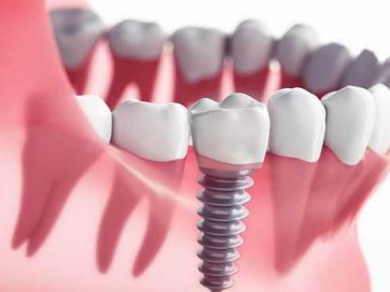Dental Implant
- Home
- Dental Implant
An implant is surgically placed by your dentist in the jawbone. After the implant integrates to your bone, it acts as a new “root” for the crown that will be replacing your missing tooth. A crown is attached to the implant and fills the space left in the mouth by the missing tooth. For this procedure to work, there must be enough bone in the jaw, and the bone has to be strong enough to hold and support the implant. If there is not enough bone, bone may need to be added with a procedure called bone augmentation. In addition, natural teeth and supporting tissues near where the implant will be placed must be in good health. Before any work is done, you will visit our Implantologist , he will review your medical and dental history, take X-rays, and create impressions of your teeth and gums so that models can be made. In some cases, the dentist also may order a computerized tomography (CT) scan of your mouth. This scan will help your dentist determine how much jawbone is available to hold the implants in place, and will show the location of structures such as nerves and sinuses so they can be avoided during surgery. If the X-rays show that your jaw does not have enough bone to hold an implant, the dentist can discuss options, such as bone grafting and bone distraction, for building up the bone.
Once you have enough bone to successfully hold an implant, we will schedule the first surgery, which involves placing the implant or implants in your jaw. Although there are several types of implants, the most popular type is root-form implants designed to serve as the root of the tooth. They are placed in the jawbone in the space created by the missing tooth. We wait till the bone and the implants fuse.
Once the implants have become fused with the bone, you can schedule the second appointment. Your dentist will confirm whether the implant is ready by taking an X-ray.
A collar, called a healing abutment is placed on the head of the implant after it is exposed. This encourages the gums to heal correctly. The collar is a round piece of metal that holds the gums away from the head of the implant. The collar will be in place for 10 to 14 days. If you previously had a removable partial denture, your dentist may adjust it so you can use it during this time.
Healing abutments help the gums to heal properly After the stitches and collar are removed, final impressions are made. These impressions will be used to make models that will look exactly like your mouth. A dental technician will use these models to make the temporary and final crowns.
An abutment and temporary crown are placed on the implant.The gums will heal around it and will look like the gums around your natural teeth. The temporary crown is made of softer material than the permanent crown. The softer material helps to cushion and protect the implant from the pressure of chewing, and gives the jawbone the opportunity to gradually get stronger.
While you are wearing your temporary crown, the permanent crown will be made. The crown can be created from a model of your teeth and gums that includes the implant or the abutment. The crown can be either cemented or screwed to the abutment. Crowns held in place by cement may look better because there is no screw hole in the crown to be seen. However, crowns held in place by a screw are easier for your dentist to remove if he or she needs to reach the implant or the tissue around the implant.
You have to care your implants the same way you care your natural teeth. It is important to brush and floss daily. You will need to visit your dentist every three months for checkups at first, but eventually you can have checkups every six months.

At Cherians Dental Clinic, we run the practice at a measured pace to provide uncompromised personal attention.
-
Dr.Cherin John
CHERIANS DENTAL CLINIC, Cherians Tower, Nedumkunnam p.o, Kottayam. Pin-686542 - drcherin@gmail.com
Quick Links
Useful Links
Make an Appointment
Cherians Dental Clinic by routes n roots
